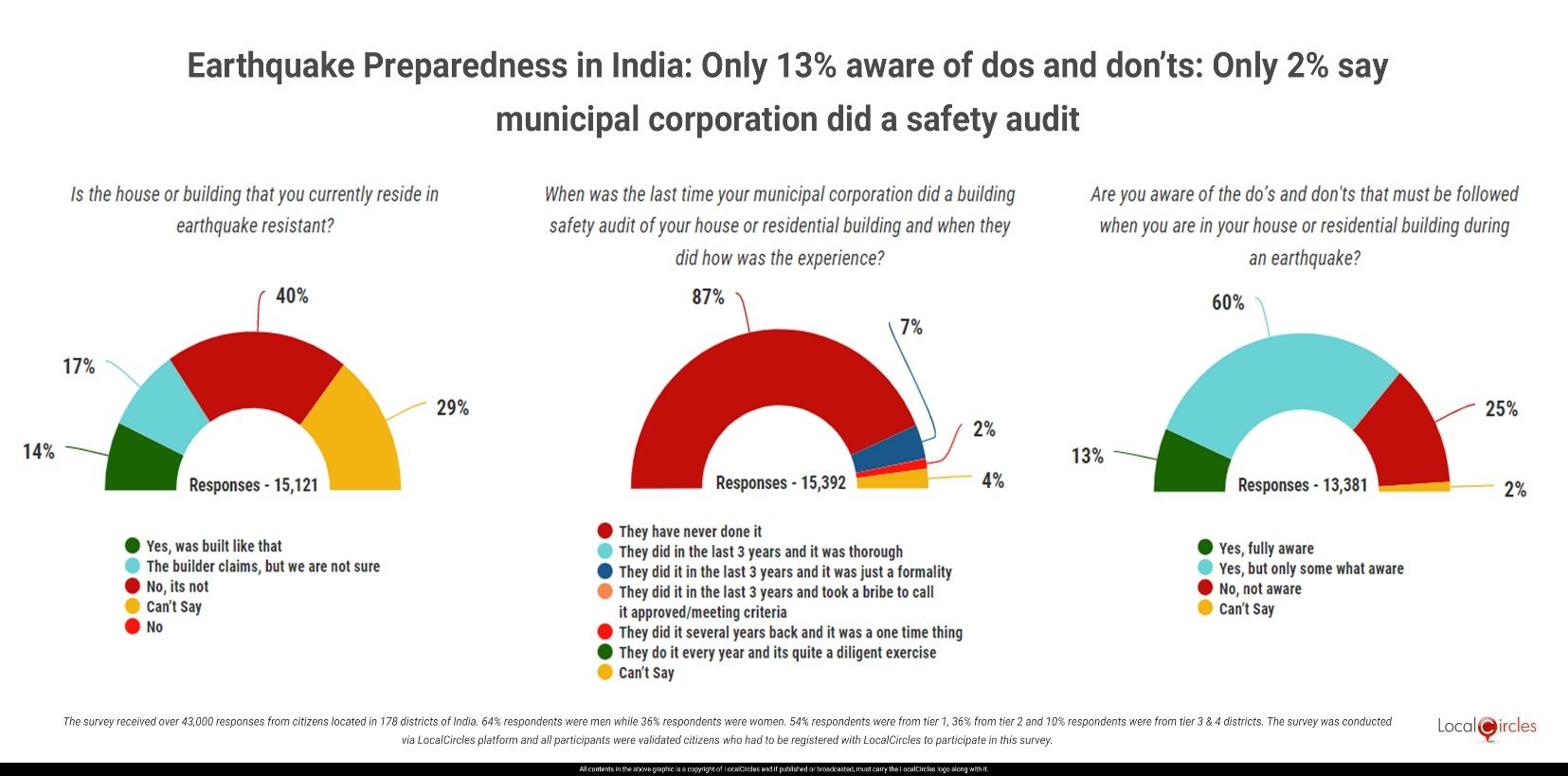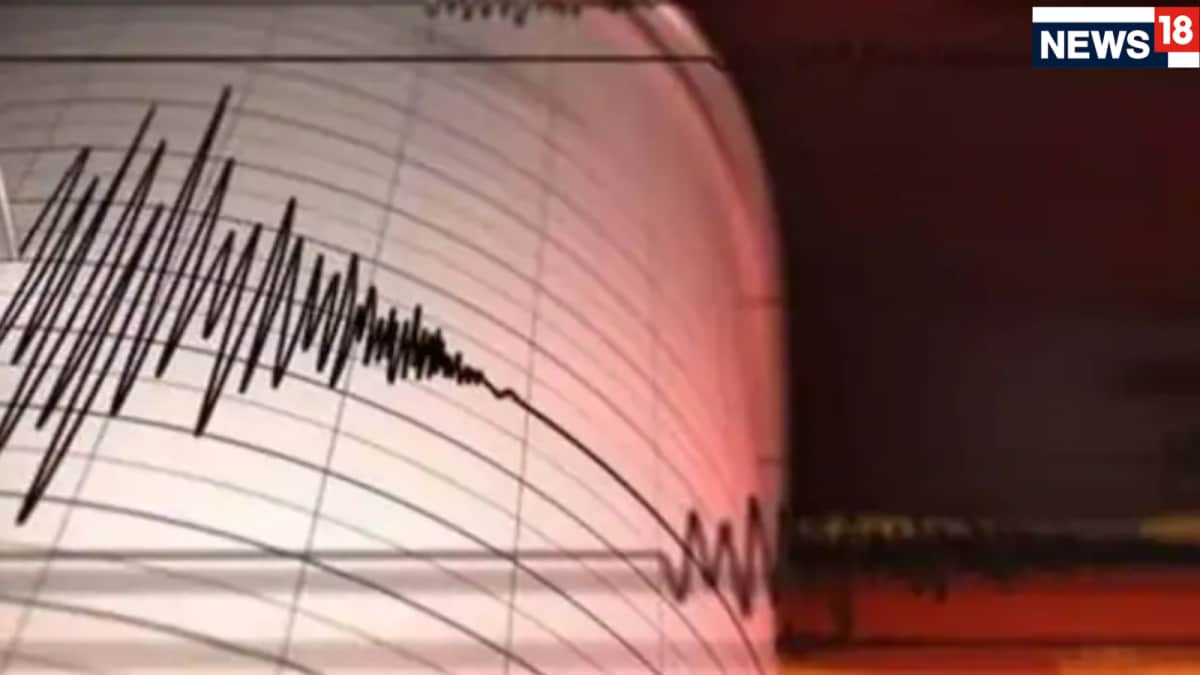Earthquake Preparedness in India: Only 13% aware of dos and don’ts: Only 2% say municipal corporation did a safety audit

February 17, 2025, New Delhi: Residents of Delhi NCR and several parts of northern India were shaken by an earthquake of 4.0 magnitude today, at approximately 5:36 AM. Woken by strong jolts, many anxious residents of high-rise buildings in Delhi, Noida, Greater Noida and Ghaziabad rushed out to the open. The earthquake's epicenter was in Delhi, at a shallow depth of only 5 km, which is likely to have intensified the tremors felt across the region. Delhi falls under Zone IV of India’s seismic map, indicating a history of moderate earthquakes. Later an earthquake of 4.0 magnitude was also reported from Bihar at 8.02 am.
As authorities urged people to remain calm, the question arose as often in the past: Are we prepared for an earthquake of high intensity? In a report, National Disaster Management Authority (NDMA), set up by the central government to prepare and guide preparedness and relief measures in times of natural disasters, states that India's increasing population and extensive ,unscientific constructions mushrooming all over, including multistoried luxury apartments, huge factory buildings, gigantic malls, supermarkets as well as warehouses and masonry buildings keep India at high risk.
During the last two decades, the country has experienced 10 major earthquakes that have resulted in over 20,000 deaths. As per the current seismic zone map of the country (IS 1893: 2002), over 59% of India’s land area is under threat of moderate to severe seismic hazard, which means it is prone to shaking of MSK Intensity VII and above (BMTPC, 2006). In fact, the entire Himalayan belt is considered prone to great earthquakes of magnitude exceeding 8.0. Scientific publications have warned of the likelihood of the occurrence of very severe earthquakes in the Himalayan region, which could adversely affect the lives of several million people in India.
The increase in earthquake risk is due to a spurt in developmental activities driven by urbanization, economic development and the globalization of India’s economy. The increase in use of high-technology equipment and tools in manufacturing and service industries has also made them susceptible to disruption due to relatively moderate ground shaking. As a result, loss of human life is not the only determinant of earthquake risk anymore. Severe economic losses leading to the collapse of the local or regional economy after an earthquake may have long-term adverse consequences for the entire country. This effect would be further magnified if an earthquake affects a mega-city, such as Delhi or Mumbai, warns NDMA. The general advisory for earthquake-prone regions is to build earthquake-resistant buildings and infrastructure. Every earthquake-prone region must build structures using materials available or produced locally and not build tall buildings. It is also important to make the public, particularly children, aware of dos and don’ts. People also must be taught basic first aid and other healthcare procedures such as CPR to be able to save lives in case there is an emergency.
Through a survey LocalCircles strives to find out how aware and how prepared citizens are if an earthquake of high intensity occurs in their city or town. The survey received over 43,000 responses from citizens located in 178 districts of India. 64% respondents were men while 36% respondents were women. 54% respondents were from tier 1, 36% from tier 2 and 10% respondents were from tier 3 & 4 districts.
Only 14% of people surveyed are sure the house or building they stay in is earthquake resistant

When building, renovating or buying a house, the first question that crops up is “how safe is the building?”. The survey thus asked, “Is the house or building that you currently reside in earthquake resistant?” To this question, 15121 citizens from across the country responded with only 14% responding that “Yes, it was built like that”. Of the remaining respondents, 40% indicated “No, it's not”; 17% indicated that while “the builder claims, we are not sure”; and 29% stated they “can’t say”. To sum up, only 14% of people surveyed are sure the house or building they stay in is earthquake resistant.
87% of those surveyed have never got a building safety audit done of the house or building where they dwell

Building maintenance may be part of normal safety protocol by the civic bodies rarely strives to ensure it. The next question asked, “When was the last time your municipal corporation did a building safety audit of your house or residential building and when they did, how was the experience?” Quite shockingly, out of 15,392 respondents to this question, 87% indicated that “they have never done it”; 7% however said “they did it in the last 3 years, but it was just a formality; 2% indicated the building safety audit was done “several years back and it was a one-time thing”; while 4% of respondents were not sure on the issue. To sum up. 87% of those surveyed have never got a building safety audit done of the house or building where they dwell. According to some citizens, this is also an area of corruption where builders at times tend to collude with municipal corporations and as a result the audit step or parts of the process are compromised.
Only 13% urban Indians surveyed are fully aware of the dos and don’ts when inside their house or building during an earthquake


Most of us must have experienced an earthquake but may still be unaware of the safety protocols. The survey asked, “Are you aware of the dos and don’ts that must be followed when you are in your house or residential building during an earthquake?” Out of 13,831 responses received to this query, 25% indicated that they are “not aware”; 60% stated that they are “only somewhat aware”; only 13% claimed they are “fully aware” and 2% expressed reluctance to give a clear answer. In essence, only 13% urban Indians surveyed are fully aware of the dos and don’ts when inside their house or building during an earthquake. Most people seem to be unaware of the basic protocol of Drop – Cover – Hold On to protect themselves from any falling objects or debris.
In conclusion, the apathy of the officials, the administrators and the public is shocking. As the survey shows only 13% of those surveyed claimed to be “fully aware” of what needs to be done in the event of an earthquake and 60% are “somewhat aware”. In the case of municipality officials/ building safety inspectors, just 2% of those surveyed claimed that their building /house was properly inspected some time back as a one-time exercise. Similarly, only 14% of those surveyed are confident that earthquake resistance measures were taken when their residential building or home was constructed. It appears too little is being done to avoid a repeat scenario of Bhuj like casualty post an earthquake. It also appears having an organization like the NDMA is not enough, particularly as the local building safety inspectors at municipal corporations fail to even get the basics done. Instead, many citizens have found them to be engaging in the process of collusion with residents who are wanting to make illegal alterations and additions to their homes. Unless India creates a national mission on building safety on the same lines as Swachh Bharat and make it a priority, not much is likely to change. With what Delhi NCR experienced this morning, if the magnitude was 6.0 instead of 4.0, the outcome would have been disastrous. With lack of preparedness and it being an earthquake susceptible zone, we indeed have a ticking time bomb situation.
Survey Demographics
The survey received over 43,000 responses from citizens located in 178 districts of India. 64% respondents were men while 36% respondents were women. 54% respondents were from tier 1, 36% from tier 2 and 10% respondents were from tier 3 & 4 districts. The survey was conducted via LocalCircles platform and all participants were validated citizens who had to be registered with LocalCircles to participate in this survey.
Also Featured In:
About LocalCircles
LocalCircles, India’s leading Community Social Media platform enables citizens and small businesses to escalate issues for policy and enforcement interventions and enables Government to make policies that are citizen and small business centric. LocalCircles is also India’s # 1 pollster on issues of governance, public and consumer interest. More about LocalCircles can be found on https://www.localcircles.com
For more queries - media@localcircles.com, +91-8585909866
All content in this report is a copyright of LocalCircles. Any reproduction or redistribution of the graphics or the data therein requires the LocalCircles logo to be carried along with it. In case any violation is observed LocalCircles reserves the right to take legal action.










